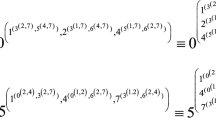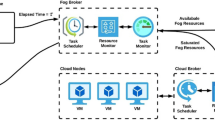Abstract
The reconfiguration capability of modern FPGA devices can be utilized to execute an application by partitioning it into multiple segments such that each segment is executed one after the other on the device. This division of an application into multiple reconfigurable segments is called temporal partitioning. We present an automated temporal partitioning technique for acyclic behavior level task graphs. To be effective, any behavior-level partitioning method should ensure that each temporal partition meets the underlying resource constraints. For this, a knowledge of the implementation cost of each task on the hardware should be known. Since multiple implementations of a task that differ in area and delay are possible, we perform design-space exploration to choose the best implementation of a task from among the available implementations.
To overcome the high reconfiguration overhead of the current day FPGA devices, we propose integration of the temporal partitioning and design space exploration methodology with block-processing. Block-processing is used to process multiple blocks of data on each temporal partition so as to amortize the reconfiguration time. We focus on applications that can be represented as task graphs that have to be executed many times over a large set of input data. We have integrated block-processing in the temporal partitioning framework so that it also influences the design point selection for each task. However, this does not exclude usage of our system for designs for which block-processing is not possible. For both block-processing and non block-processing designs our algorithm selects the best possible design point to minimize the execution time of the design.
We present an ILP-based methodology for the integrated temporal partitioning, design space exploration and block-processing technique that is solved to optimality for small sized design problems and in an iterative constraint satisfaction approach for large sized design problems. We demonstrate with extensive experimental results for the Discrete Cosine Transform (DCT) and random graphs the validity of our approach.
Similar content being viewed by others
References
Xilinx Inc., http://www.xilinx.com. “Data Book and Application Notes. ”
Altera Inc., http://www.altera.com. “Data Book and Application Notes. ”
Atmel Inc., http://www.atmel.com. “Data Book and Application Notes. ”
B.L. Hutchings and M.J. Wirthlin, “Implementation Approaches for Reconfigurable Logic Applications,” International Workshop on Field-Programmable Logic and Applications, FPL, Springer, 1995, pp. 419–428.
M. Dorfel and R. Hofmann, “APrototyping System for High Performance Communication Systems,” IEEE Workshop on Rapid System Prototyping, RSP, IEEE Computer Society Press, 1998, pp. 84–88.
J. Babb, R. Tessier, M. Dahl, S. Hanono, D. Hoki, and A. Agarwal, “Logic Emulation with Virtual Wires,” IEEE Transactions on Computer Aided Design of Integrated Circuits and Systems, vol. 16, no.6, 1997, pp. 609–626.
M. Vasilko and D. Ait-Boudaoud, “Architectural Synthesis for Dynamically Reconfigurable Logic,” International Workshop on Field-Programmable Logic and Applications, FPL, Springer, 1996, pp. 290–296.
K.M. GajjalaPurna and D. Bhatia, “Temporal Partitioning and Scheduling for Reconfigurable Computing,” FPGAs for Custom Computing Machines, FCCM, IEEE Computer Society Press, 1998, pp. 329–330.
J. Spillane and H. Owen, “Temporal Partitioning for Partially-Reconfigurable-Field-Programmable Gate,” Reconfigurable Architectures Workshop, RAW in IPPS/SPDP, Springer, 1998, pp. 37–42.
M. Kaul and R. Vemuri, “Optimal Temporal Partitioning and Synthesis for Reconfigurable Architectures,” Design, Automation and Test in Europe, DATE, IEEE Computer Society Press, 1998, pp. 389–396.
S. Trimberger, “Scheduling Designs into a Time-Multiplexed FPGA,” ACM/SIGDA International Symposium on Field Programmable Gate Arrays, FPGA, ACM Press, 1998, pp. 153–160.
M. Kaul, R. Vemuri, S. Govindarajan, and I. Ouaiss, “An Automated Temporal Partitioning and Loop Fission Approach for FPGA Based Reconfigurable Synthesis of DSP Applications,” Design Automation Conference, DAC, IEEE Computer Society Press, 1999, pp. 616–622.
D.S. Rao and F. Kurdahi, “Hierarchical Design Space Exploration for a Class of Digital Systems,” IEEE transactions on Very Large Scale Integration (VLSI) Systems, vol. 1, no.3, 1993, pp. 282–294.
G.D. Micheli, Synthesis and Optimization of Digital Circuits, McGraw-Hill, 1994.
I. Ouaiss, S. Govindarajan, V. Srinivasan, M. Kaul, and R. Vemuri, “An Integrated Partitioning and Synthesis System for Dynamically Reconfigurable Multi-FPGA Architectures,” Reconfigurable Architectures Workshop, RAW in IPPS/SPDP, Springer, 1998, pp. 31–36.
M. Xu and F. Kurdahi, “Layout Driven High Level Synthesis for FPGA Based Architectures,” Design Automation and Test in Europe, DATE, IEEE Computer Society Press, 1998, pp. 446–450.
M. Wolf, High Performance Compilers for Parallel Computing, Addison-Wesley Publishers, 1996.
S.Y. Kung, VLSI Array Processors, Prentice Hall, 1988.
K. Roy-Neogi and C. Sechen, “Multiple FPGA partitioning with performance optimization,” ACM/SIGDA International Symposium on Field Programmable Gate Arrays, FPGA, ACM Press, 1995, pp. 146–152.
P. Chan, M. Schlag, and J. Zien, “Spectral-Based Multi-Way FPGA Partitioning,” ACM/SIGDA International Symposium on Field Programmable Gate Arrays, FPGA, ACM Press, 1995, pp. 133–139.
W. Fang and A. Wu, “A Hierarchical Functional Structuring and Partitioning Approach for Multiple-FPGA Implementations,” IEEE Transactions on Computer-Aided Design of Integrated Circuits and Systems, vol. 16, no.10, 1997, pp. 1188–1195.
H. Schmit, L. Arnstein, D. Thomas, and E. Lagnese, “Behavioral Synthesis for FPGA-Based Computing,” FPGAs for Custom Computing Machines, FCCM, IEEE Computer Society Press, 1994, pp. 125–132.
R.D. Hudson, D.I. Lehn, and P.M. Athanas, “A Run-Time Reconfigurable Engine for Image Interpolation,” FPGAs for Custom Computing Machines, FCCM, IEEE Computer Society Press, 1998, pp. 88–95.
M.J. Wirthlin and B.L. Hutchings, “Sequencing Run-Time Reconfigured Hardware with Software,” ACM/SIGDA International Symposium on Field Programmable Gate Arrays, FPGA, ACM Press, 1996, pp. 122–128.
M. Gokhale and J.M. Stone, “NAPA C: Compiling for Hybrid RISC/FPGA Architectures,” FPGAs for Custom Computing Machines, FCCM, IEEE Computer Society Press, 1998, pp. 126–135.
W. Luk, N. Shirazi, and P. Cheung, “Automating Production of Run-Time Reconfigurable Designs,” FPGAs for Custom Computing Machines, FCCM, IEEE Computer Society Press, 1998, pp. 147–156.
M. Chu, N. Weaver, K. Sulimma, A. DeHon, and J. Wawrzynek, “Object Oriented Circuit-Generators in Java,” FPGAs for Custom Computing Machines, FCCM, IEEE Computer Society Press, 1998, pp. 158–166.
M. Kaul and R. Vemuri, “Temporal Partitioning Combined with Design Space Exploration for Latency Minimization of Run-Time Reconfigured Designs,” Design Automation and Test in Europe, DATE, IEEE Computer Society Press, 1999, pp. 202–209.
M.J. Wirthlin and B.L. Hutchings, “A Dynamic Instruction Set Computer,” FPGAs for Custom Computing Machines, FCCM, IEEE Computer Society Press, 1995, pp. 99–106.
A. Kalavade, “System-Level Codesign of Mixed Hardware-Software Systems,” Ph.D. Thesis, University of California, Berkeley, 1995.
C.H. Gebotys, “Optimal Synthesis of Multichip Architectures,” IEEE ICCAD, IEEE Computer Society Press, 1992, pp. 238–241.
R. Niemann and P. Marwedel, “An Algorithm for Hardware/Software Partitioning Using Mixed Integer Linear Programming,” European Design and Test Conference, ED&TC, 1996, pp. 473–479.
C.H. Gebotys and M.I. Elmasry, Optimal VLSI Architectural Synthesis, Kluwer Academic Publishers, 1992.
P. Hansen, B. Jaumard, and V. Mathon, “Constrained Nonlinear 0-1 Programming,” ORSA Journal of Computing, vol. 5, no.2, 1993, pp. 97–119.
F. Glover and E. Woolsey, “Converting the 0-1 Polynomial Programming Problem to a 0-1 Linear Program,” Operations Research, vol. 21, no.1, 1974, pp. 156–161.
G.K. Wallace, “The JPEG Still Picture Compression Standard,” ACM Communications, 1991.
S. Trimberger, D. Carberry, A. Johnson, and J. Wong, “A Time-Multiplexed FPGA,” FPGAs for Custom Computing Machines, FCCM, IEEE Computer Society Press, 1997, pp. 22–28.
S.M. Scalera and J.R. Vazquez,“The Design and Implementation of a Context Switching FPGA,” FPGAs for Custom Computing Machines, FCCM, IEEE Computer Society Press, 1998, pp. 78–85.
Annapolis Micro Systems, Inc., WILDFORCE Reference Manual, Document #1189–Release Notes.
Y. Hung and A.C. Parker, “High-Level Synthesis with Pin Constraints for Multiple-Chip Designs,” Design Automation Conference, DAC, IEEE Computer Society Press, 1992, pp. 231–234.
Author information
Authors and Affiliations
Rights and permissions
About this article
Cite this article
Kaul, M., Vemuri, R. Design-Space Exploration for Block-Processing Based Temporal Partitioning of Run-Time Reconfigurable Systems. The Journal of VLSI Signal Processing-Systems for Signal, Image, and Video Technology 24, 181–209 (2000). https://doi.org/10.1023/A:1008193422345
Published:
Issue Date:
DOI: https://doi.org/10.1023/A:1008193422345




